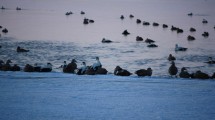Abstract
We studied parasitism by gut protozoans (Apicomplexa: Eugregarinidae) in the damselfly, Nehalennia irene (Hagen) (Odonata: Coenagrionidae). We tested whether there was any seasonal pattern, as has been found for other parasites of damselflies and which has implications for selection on emergence and breeding. Using aggregate data from 12 date-by-site comparisons involving five sites, we found that both prevalence and intensity of gregarine parasitism were seasonally unimodal. Parasitism first increased and then declined seasonally after peaking mid-season. This damselfly species has shown seasonal increases in density followed by declines at several sites including a site sampled in this study. Therefore, similar seasonal changes in a directly transmitted parasite were expected and are now confirmed. Other factors that might account for seasonal changes in parasitism by gregarines are either unlikely or can be discounted including sampling of older damselflies mid-season but not late in the season, or sex biases in parasitism and overrepresentation of the more parasitized sex mid-season.


Similar content being viewed by others
References
Åbro A (1971) Gregarines: their effects on damselflies (Odonata: Zygoptera). Entomol Scand 2:294–300
Åbro A (1974) The gregarine infection in different species of Odonata from the same habitat. Zoolog Scripta 3:111–120
Åbro A (1976) The mode of gregarine infection in zygoptera (Odonata). Zoolog Scripta 5:265–275
Åbro A (1987) Gregarine infection of Zygoptera in diverse habitats. Odonatologica 16:119–128
Åbro A (1990) The impact of parasites in adult populations of zygoptera. Odonatologica 19:223–233
Åbro A (1996) Gregarine infection of adult Calopteryx virgo L. (Odonata: Zygoptera). J Nat Hist 30:855–859
Altizer S, Dobson A, Hossein P, Hudson P, Pascual M, Rohani P (2006) Seasonality and the dynamics of infectious diseases. Ecol Lett 9:467–484
Anholt BR (1992) Sex and habitat differences in feeding by an adult damselfly. Oikos 65:428–432
Bush AO, Lafferty KD, Lotz JM, Shostak AW (1997) Parasitology meets ecology on its own terms: Margolis et al. re-visited. J Parasitol 83:575–583
Clopton RE (1997) Hotel intestine gregarine protocol handbook. http://science.peru.edu/gregarina/html/protocols.html. Accessed 15 June 1997
Forbes MR, Baker RL (1991) Condition and fecundity of the damselfly, Enallagma ebrium (Hagen): the importance of ectoparasites. Oecologia 86:335–341
Forbes MRL, Richardson JML, Baker RL (1995) Frequency of female morphs is related to an index of male density in the damselfly, Nehellenia irene (Hagen). Ecoscience 2:28–33
Gillespie S (2010) Factors affecting parasite prevalence among wild bumblebees. Ecol Entomol 35:737–747
Hassall C, Lowe CD, Harvey IF, Watts PC, Thompson DC (2010) Phenology determines seasonal variation in ectoparasite loads in a natural insect population. Ecol Entomol 35:514–522
Hecker KR (1999) Testing for sex biases and morph biases in parasitism of Zygopterans (Odonata) by Gregarines (Eugregarinidae). Dissertation, Carleton University
Hecker KR, Forbes MR, Léonard NJ (2002) Parasitism of Enallagma boreale damselflies by gregarines: sex biases and relations to adult survivorship. Can J Zool 80:162–168
Locklin JL, Vodopich DS (2009) Bidirectional gender biases of gregarine parasitism in two coexisting dragonflies (Anisoptera: Libellulidae). Odonatologica 38:133–140
Locklin JL, Vodopich DS (2010a) Patterns of gregarine parasitism in dragonflies: host, habitat, and seasonality. Parasitol Res 107:75–87
Locklin JL, Vodopich DS (2010b) Eugregarine parasitism of Erythemis simplicicollis (Say) at a constructed wetland: a fitness cost to females? (Anisoptera: Libellulidae). Odonatologica 39:319–331
MacIntosh AJJ, Hernandez AD, Huffman MA (2010) Host age, sex, and reproductive seasonality affect nematode parasitism in wild Japanese macaques. Primates 51:353–364
Prinz K, Kelly TC, O’Riordan RM, Culloty SC (2010) Temporal variation in prevalence and cercarial development of Echinostephilla patella (Digenea, Philophthalmidae) in the intertidal gastropod Patella vulgata. Acta Parasitologica 55:39–44
Smith BP, Cook WJ (1991) Negative covariance between larval Arrenurus species and Limnochares americana (Acari: Hydrachnidia) on male Leucorhinnia frigida (Odonata: Libellulidae) and its relationship to the host’s age. Can J Zool 69:226–231
Van Gossum H, Beirinckx K, Forbes MR, Sherratt TN (2007) Do current hypotheses explain continental and seasonal variation in female morph frequencies of the damselfly, Nehallenia irene? Biol J Linn Soc 90:501–508
Walker EM (1953) The Odonata of Canada and Alaska, vol 1. University of Toronto Press, Toronto
Zar JH (1996) Biostatistical analysis, 3rd edn. Prentice-Hall, Upper Saddle River
Zuk M (1987) Seasonal and individual variation in gregarine parasite levels in the field crickets Gryllus veletis and G. pennsylvanicus. Ecol Entomol 12:341–348
Acknowledgments
We would like to thank Frank Phelan for assistance in the field and Richard Clopton for help with gregarine identification. This was partly funded by a NSERC discovery grant awarded to MRF.
Author information
Authors and Affiliations
Corresponding author
Rights and permissions
About this article
Cite this article
Forbes, M.R., Mlynarek, J.J., Allison, J. et al. Seasonality of gregarine parasitism in the damselfly, Nehalennia irene: understanding unimodal patterns. Parasitol Res 110, 245–250 (2012). https://doi.org/10.1007/s00436-011-2478-1
Received:
Accepted:
Published:
Issue Date:
DOI: https://doi.org/10.1007/s00436-011-2478-1




